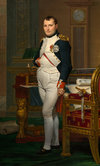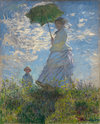NGA permanent collection Flashcards

Jacques-Louis David (French)
The Emporer Napoleon in His Study at the Tuileries, 1812
Oil on canvas, 6’ 8 ¼”x 4’ 4 ¼”
Neoclassicism
In this painting, David transform his subject into a politically powerful icon. Napoleon is dressed in his uniform as a colonel of the Foot Grenadiers of the Imperial Guard. His pose contrasts to the formality of his costume. His cuffs are unbuttoned, his leggings wrinkled, and his hair disheveled. David explained that his appearance was designed to show that Napoleon had spent the night in his study composing the Napoleonic Code, an impression enforced by details, such as the flickering candles that are almost extinguished, the quill pen and papers scattered on the desk, and the clock on the wall which points to 4:13 a.m. The strategically placed the sword on the chair to alludes to Napoleon’s military success, while the prominent display of the word “Code” in his papers, suggests his administrative achievements. (http://www.nga.gov/content/ngaweb/Collection/art-object-page.46114.html?opensection=inscription)

Vincent Van Gogh (Dutch)
Green Wheat Fields, Auvers, 1890
Oil on canvas, 2’ 4 ½” × 3’
Post-Impressionism
Green Wheat Fields, Auvers was painted during the final months of Van Gogh’s life. Two-thirds of the composition consists of the field in a rich range of greens and blues, punctuated by outbursts of yellow flowers. Van Gogh’s energetic strokes describe the movement of grassy stalks in the breeze, their patterned undulations creating a woven integral form anchored at the right by a juncture of field, road, and sky. Over the scene the clouds whip around in spinning circles, opening out and closing in, Van Gogh’s brush squiggling across the surface in broad calligraphic strokes. The paint is applied in thick impasto, creating the textured surface of Van Gogh’s best-loved paintings. (http://www.nga.gov/content/ngaweb/Collection/art-object-page.163323.html)

Claude Monet (French)
Woman with a Parasol - Madame Monet and Her Son, 1875
Oil on canvas, 3’ 3 3/8” x 2’ 7 7/8”
Impressionism
At its purest, impressionism was attuned to landscape painting, a subject Monet favored. In this painting, his skill as a figure painter is equally evident. Contrary to the artificial conventions of academic portraiture, Monet delineated the features of his sitters as freely as their surroundings. The spontaneity and naturalness of the resulting image were praised when it appeared in the second impressionist exhibition in 1876. Woman with a Parasol was painted outdoors, probably in a single session of several hours’ duration. The artist intended the work to convey the feeling of a casual family outing rather than a formal portrait, and used pose and placement to suggest that his wife and son interrupted their stroll while he captured their likenesses. The brevity of the moment portrayed here is conveyed by animated brushstrokes of vibrant color, hallmarks of the style Monet was instrumental in forming. Bright sunlight shines from behind Camille to whiten the top of her parasol and the flowing cloth at her back, while colored reflections from the wildflowers below touch her front with yellow. (http://www.nga.gov/content/ngaweb/Collection/art-object-page.61379.html)
Name (Nationality)
Title, Date
Medium, size
Style
Note/description (cite)


